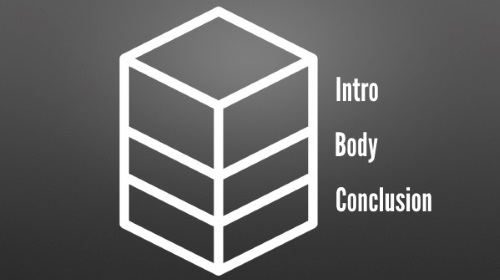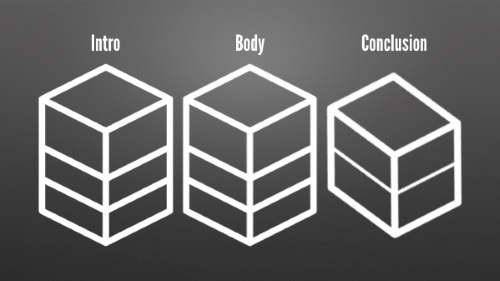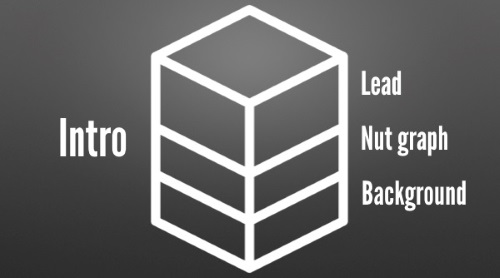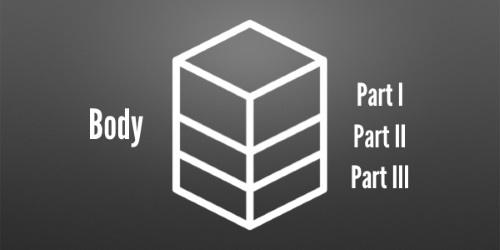Strathcona County masters ‘stack of boxes’ structure
Here’s the good news: You already know how to organize your copy.

Just think back to what your third-grade English teacher taught you. Most pieces of writing have three sections:
- Introduction: the beginning
- Body: the middle
- Conclusion: the end
That makes writing a feature story as easy as 1-2-3.
A fill-in-the-boxes structure
Draw these three sections on a piece of paper, and your story looks like this:

OK, so it’s not quite that easy. Because each of those sections has its own parts.

This simple, elegant structure still works for virtually everything but bad news, crisis communications or communications distributed via telegraph.
So what goes into each box?
1. Introduction
The introduction has three parts: the lead, the nut graph and sometimes a background section.

A. Lead. The job of the lead is to grab readers and pull them into your piece. (Repeat after me: The job of the lead is not to tell the whole story. That’s what the whole story is for.) To do that, make your lead:
- Concrete, or tangible. Is it something you can process through your five senses? Is it packed with concrete details? Or is it a startling statistic? If so, you’re good.
- Creative. Have you stolen a trick from the fiction writers? Are you using techniques like anecdote, human interest or metaphor? If so, you’re even better.
- Provocative. For bonus points: Have you raised a question in the reader’s mind that she can only answer by reading the rest of your piece? (There’s a big difference between raising a question and asking one. The reader is the one who should be asking the question.) If so, you’re awesome!
In one of my favorite befores-and-afters ever, here’s a lead by Elizabeth Tadman-Kickham, a communication specialist for Strathcona County, Canada, before applying the feature-style story structure:
And here’s that lead after mastering this approach:
I’ve shared this before-and-after with probably 5,000 people in nearly 100 writing workshops, and only three people have ever preferred the original.
B. Nut graph. In this paragraph, you’ll:
- Put the story into a nutshell, communicating your key message. After getting readers’ attention with a shiny object in the lead, tell them where you’re taking them in the nut graph.
- Make a promise to the reader, letting them know what’s in it for them: If you read this, you will learn how to …
- Summarize your story in a sentence or two. Here’s where you tell ’em what you’re going to tell ’em.
So, how did Elizabeth Tadman-Kickham do? She didn’t write a nut graph for her original news story, because inverted pyramids don’t have nut graphs
Here’s the nut graph in her rewrite:
C. Background section. Also known as the blah blah blah, the background section broadens the story out. The background section is where to place:
- Definitions. Want to include the boilerplate of your product or company? Get the lead out of the lead and move the definition to the third paragraph.
- Broader context. Think of your lead as a close-up. The background section is a wide shot. Answer the reader’s question, “Why are you telling me this story now?”
- History or trends. Don’t start your story with a history lesson — or even a trend. If you’re on the 4th phase of a 44-phase project, don’t drone on about it in the lead. Save it for the third paragraph.
Elizabeth Tadman-Kickham’s original story didn’t have a background section. Inverted pyramids don’t have them, and she’d used up all of her background in that (definition) lead.
Here’s the background section in her rewrite:
I love that last phrase, Elizabeth!
2. Body
If the nut graph is where you tell ’em what you’re going to tell ’em, the body is where you tell them.

Avoid the muddle in the middle: Make sure the body has parts.
And move it along: The brisker, the better.
Here’s the body of Elizabeth Tadman-Kickham’s original piece:
Opening Ceremonies Fireworks – weather permitting
- Wednesday, August 27 at 10 p.m.
- Public viewing at the Kinsmen Leisure Centre
- 2001 Oak Street, Sherwood Park.
55+ Health & Wellness Expo
- Thursday, August 28 from noon to 8 p.m.
- Millennium Place
- 2000 Premier Way, Sherwood Park
Ardrossan Mini Art Market – weather permitting
- Thursday, August 28 from 11 a.m. to 3 p.m.
- Ardrossan Recreation Complex
- 80-1 Avenue, Ardrossan
Art: Objet de Sport, an exhibit celebrating Canadian and Olympic sport and recreation.
- On until September 6
- Gallery@501
- #120, 501 Festival Avenue
Her rewrite is much tighter and invites readers in:
- August 27 – Opening Ceremonies Fireworks at Broadmoor Lake Park
- August 28 – 55+ Health & Wellness Expo at Millennium Place
- August 28 – Ardrossan Mini Art Market at Ardrossan Recreation Complex
- July 10 to September 6 – Art: Objet de Sport at Gallery@501
3. Conclusion
The conclusion has two parts: a wrapup and a kicker.

A. Wrapup. If the nut graph is where you tell ’em what you’re going to tell ’em, and the body is where you tell ’em, then the wrapup is where you tell ’em what you told ’em.
Tip: Copy your nut graph, paste it into the conclusion and massage. That’s all you need for your wrapup.
Elizabeth Tadman-Kickham’s original wrapup:
Her revision is a bit more streamlined:
B. Kicker. To leave a lasting impression, go with something that’s concrete, creative and provocative. That’s right — everything that works for a lead works just as well for a kicker.
The great thing about inverted pyramids is that when you get to the end, you just stop typing. That’s why Elizabeth Tadman-Kickham didn’t include a kicker.
But features require an ending. Here’s the kicker from Elizabeth’s rewrite:
This to me is the least satisfying part of Elizabeth’s rewrite. I wish instead she had circled back to the top and quoted Florence Storch, that 101-year-old woman who’s running around with a pointed stick and knows how to use it. Maybe something like:
All in all, though, a fantastic rewrite. Congratulations, Elizabeth.
Let’s see yours! Please share your befores and afters in the comments section.
|
Learn how to master a structure that’s been proven in the lab to grab readers’ attention, pull them through the piece and leave a lasting impression at our Catch Your Readers Master Class on Oct. 2-3 in Dallas.
Save $100 when you book by Aug. 2.
|
